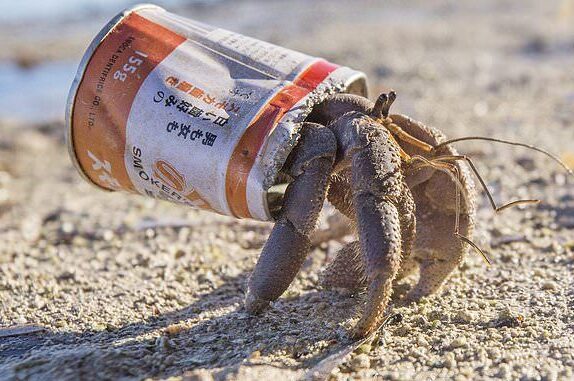
A concerning trend has emerged among hermit crabs worldwide, as these creatures, known for scavenging shells as protective armour, increasingly turn to plastic waste instead.
This revelation stems from an analysis of photographs captured by wildlife enthusiasts and shared online, leaving scientists disheartened by the extent of the animals’ reliance on human-generated debris.
The study, detailed in the journal Science of the Total Environment, paints a stark picture, with two-thirds of hermit crab species documented inhabiting “artificial shells” – discarded human items.
Leveraging social media and photo-sharing platforms, researchers like Marta Szulkin, an urban ecologist from the University of Warsaw, alongside colleagues Zuzanna Jagiello and Łukasz Dylewski, unearthed a total of 386 instances of hermit crabs utilising artificial shells, predominantly plastic caps.
Marta Szulkin said, “We started to notice something completely out of the ordinary.
“Instead of being adorned with a beautiful snail shell, which is what we’re used to seeing – they would have a red plastic bottle cap on their back or piece of light bulb.”
“According to our calculations, 10 out of the 16 species of land hermit crabs in the world use this type of shelter and it’s been observed in all tropical regions of the Earth.”
Despite this revelation, the implications of this shift remain ambiguous. Scientists are uncertain whether these materials harbour detrimental effects or perhaps offer benefits to the small, delicate crustaceans.
“When I first saw these pictures, I felt it was heart-breaking,” Prof Szulkin said. “At the same time, I think we really need to understand the fact that we are living in a different era and animals are making use of what is available to them.”
This global phenomenon of hermit crabs embracing artificial shells raises a multitude of questions regarding their interaction with plastic debris.
“We saw it in two-thirds of all terrestrial hermit crab species,” said Prof Szulkin. “That’s what we could identify just by using pictures taken by tourists.”
Beyond assessing potential harm, researchers seek to unravel how this reliance may influence evolutionary trajectories.
Hermit crabs, a species adapted to repurpose discarded snail shells for protection, face increasing scarcity of natural shells. In the absence of suitable alternatives, competition among crabs escalates.
“What we don’t know is how much the element of novelty might affect them – and whether the crabs will fight over artificial plastic shells,” explained Prof Szulkin.
Yet, the introduction of plastic shells introduces a novel dynamic, prompting speculation about altered behaviours and survival strategies.
With natural shell availability on the decline, the accessibility of artificial substitutes offers a potential lifeline, particularly for smaller, weaker crabs burdened by traditional, heavier shells.
The abundance of plastic debris in marine environments compounds this dilemma. Recent studies estimate a staggering 171 trillion pieces of plastic polluting our oceans, a figure projected to nearly triple by 2040 without intervention.
Despite these dire projections, optimism persists, with 2024 heralding the potential signing of a global treaty to address plastic pollution. Mark Miodownik, a professor of materials and society at University College London, underscores the profound lesson embedded in these images, urging reflection on humanity’s role in mitigating environmental degradation.
“Just like the hermit crabs,” he said, “we should be reusing plastics much more, instead of discarding it.”
——————————————————————————
At Natural World Fund, we are passionate about stopping the decline in our wildlife.
The decline in our wildlife is shocking and frightening. Without much more support, many of the animals we know and love will continue in their decline towards extinction.
When you help to restore a patch of degraded land through rewilding to forests, meadows, or wetlands, you have a massive impact on the biodiversity at a local level. You give animals a home and food that they otherwise would not have had, and it has a positive snowball effect on the food chain.
We are convinced that this is much better for the UK than growing lots of fast-growing coniferous trees, solely to remove carbon, that don’t actually help our animals to thrive.
This is why we stand for restoring nature in the UK through responsible rewilding. For us, it is the right thing to do. Let’s do what’s right for nature!
Donate today at https://naturalworldfund.com/ and join in the solution!

